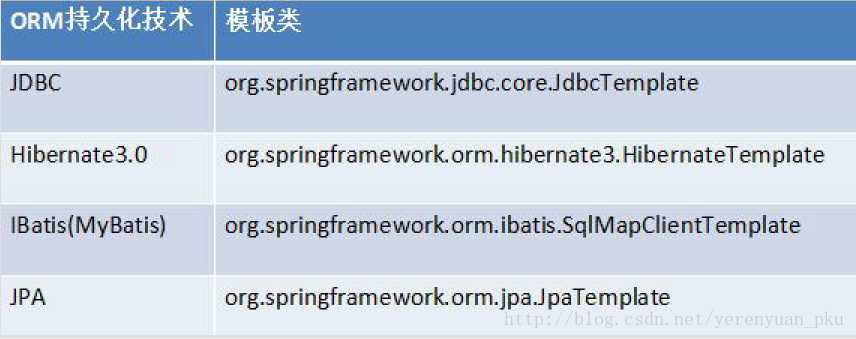标签:sel 语句 dbutil nod jar包 count() read led throw
http://blog.csdn.net/yerenyuan_pku/article/details/69790950
之前我已讲过Spring使用AspectJ通过配置文件的方式来进行AOP的开发,现在就来讲怎样使用注解方式进行AOP的开发。

引入Spring的配置文件。主要引入AOP的约束:
<?xml version="1.0" encoding="UTF-8"?>
<beans xmlns="http://www.springframework.org/schema/beans"
xmlns:xsi="http://www.w3.org/2001/XMLSchema-instance"
xmlns:aop="http://www.springframework.org/schema/aop" xsi:schemaLocation="
http://www.springframework.org/schema/beans
http://www.springframework.org/schema/beans/spring-beans.xsd
http://www.springframework.org/schema/aop
http://www.springframework.org/schema/aop/spring-aop.xsd">
</beans>编写目标类。
在Web项目的src目录下创建一个cn.itcast.aop包,并在该包下编写一个Book类:
public class Book {
public void add() {
System.out.println("book add.................");
}
}编写切面类。
再在cn.itcast.aop包下编写一个MyBook增强类:
public class MyBook {
public void before1() {
System.out.println("before........");
}
}在增强的类上面使用@Aspect注解
@Aspect
public class MyBook {
public void before1() {
System.out.println("before........");
}
}在增强类的方法里面,使用注解配置通知类型:
@Aspect
public class MyBook {
// 前置通知
// *:方法的访问修饰符,也可写为execution(public void cn.itcast.aop.Book.*(..)),但一般都不会用
@Before("execution(* cn.itcast.aop.Book.*(..))")
public void before1() {
System.out.println("before........");
}
}AspectJ的AOP的注解:
@Aspect:定义切面类的注解@Before:前置通知,相当于BeforeAdvice@AfterReturning:后置通知,相当于AfterReturningAdvice@Around:环绕通知,相当于MethodInterceptor@AfterThrowing:抛出通知,相当于ThrowAdvice@After:最终final通知,不管是否异常,该通知都会执行@Pointcut:定义切入点的注解开启AspectJ的注解
<aop:aspectj-autoproxy></aop:aspectj-autoproxy>创建Book类和MyBook类的两个对象(使用配置文件)
<bean id="book" class="cn.itcast.aop.Book"></bean>
<bean id="myBook" class="cn.itcast.aop.MyBook"></bean>最后在cn.itcast.aop包下编写一个TestDemo单元测试类
public class TestDemo {
@Test
public void testBook() {
ApplicationContext context = new ClassPathXmlApplicationContext("bean1.xml");
Book book = (Book) context.getBean("book");
book.add();
}
}测试即可。
Spring是一个分层的JavaSE/EEfull-stack(一站式)轻量级开源框架。它针对JavaEE三层中的每一层都提供了不同的解决技术,在dao层,Spring提供了JDBC模板的技术,可对数据库进行CRUD操作。Spring提供了很多持久层技术的模板类简化了编程,如下图: 
我再次加以说明:Spring框架对不同的持久层技术做了封装,如对传统的JDBC使用JdbcTemplate进行了封装,对Hibernate框架使用HibernateTemplate进行了封装。JdbcTemplate对JDBC进行了简单封装,使用类似于dbutils,但是使用并没有dbutils方便,只是提供了一种实现的方式而已。下面来演示使用JdbcTemplate模板类实现CRUD操作。
首先创建数据库和表,如下:
create database spring_lee;
use spring_lee;
DROP TABLE IF EXISTS `user`;
CREATE TABLE `user` (
`username` varchar(100) DEFAULT NULL,
`password` varchar(100) DEFAULT NULL
) ENGINE=InnoDB DEFAULT CHARSET=utf8;使用JdbcTemplate模板类还须导入jar包,先引入JdbcTemplate的jar包:
但我们要知道spring-jdbc-4.2.4.RELEASE.jar包才是最主要的。除此之外还须导入MySQL数据库驱动的jar包。
在src目录下创建一个cn.itcast.jdbcTemplate包,并在该包下编写一个JdbcTemplateDemo1单元测试类。现在要编写一个add方法来测试添加操作。
public class JdbcTemplateDemo1 {
// 1.添加操作
@Test
public void add() {
// 1.设置数据库相关信息(JDBC模板依赖连接池获得数据库连接,所以必须先构造连接池)
DriverManagerDataSource dataSource = new DriverManagerDataSource(); // 数据源
dataSource.setDriverClassName("com.mysql.jdbc.Driver");
dataSource.setUrl("jdbc:mysql:///spring_lee");
dataSource.setUsername("root");
dataSource.setPassword("yezi");
// 2.做添加的操作
JdbcTemplate jdbcTemplate = new JdbcTemplate(dataSource);
String sql = "insert into user values(?,?)";
int rows = jdbcTemplate.update(sql, "liayun", "lee");
System.out.println(rows);
}
}注意:JDBC模板依赖连接池获得数据库连接,所以必须先构造连接池,然后再创建JdbcTemplate模板类对象。而且还须用到JdbcTemplate模板类的update方法: 
这个方法中有两个参数:
现在要在单元测试类中编写一个update方法来测试修改操作。
public class JdbcTemplateDemo1 {
// 2.修改操作
@Test
public void update() {
// 1.设置数据库相关信息
DriverManagerDataSource dataSource = new DriverManagerDataSource(); // 数据源
dataSource.setDriverClassName("com.mysql.jdbc.Driver");
dataSource.setUrl("jdbc:mysql:///spring_lee");
dataSource.setUsername("root");
dataSource.setPassword("yezi");
// 实现修改操作
JdbcTemplate jdbcTemplate = new JdbcTemplate(dataSource);
String sql = "update user set password=? where username=?";
int rows = jdbcTemplate.update(sql, "9999", "liayun");
System.out.println(rows);
}
}现在要在单元测试类中编写一个delete方法来测试删除操作。
public class JdbcTemplateDemo1 {
// 3.删除操作
@Test
public void delete() {
// 1.设置数据库相关信息
DriverManagerDataSource dataSource = new DriverManagerDataSource(); // 数据源
dataSource.setDriverClassName("com.mysql.jdbc.Driver");
dataSource.setUrl("jdbc:mysql:///spring_lee");
dataSource.setUsername("root");
dataSource.setPassword("yezi");
// 实现删除操作
JdbcTemplate jdbcTemplate = new JdbcTemplate(dataSource);
String sql = "delete from user where username=?";
int rows = jdbcTemplate.update(sql, "liayun");
System.out.println(rows);
}
}现在要在单元测试类中编写一个testCount方法来测试查询表中记录数的操作。
public class JdbcTemplateDemo1 {
// 查询表记录数
@Test
public void testCount() {
// 1.设置数据库相关信息
DriverManagerDataSource dataSource = new DriverManagerDataSource(); // 数据源
dataSource.setDriverClassName("com.mysql.jdbc.Driver");
dataSource.setUrl("jdbc:mysql:///spring_lee");
dataSource.setUsername("root");
dataSource.setPassword("yezi");
// 2.创建JdbcTemplate模板类的对象
JdbcTemplate jdbcTemplate = new JdbcTemplate(dataSource);
// 3.sql语句
String sql = "select count(*) from user";
// 4.调用JdbcTemplate模板类里面的方法
// 返回int类型
int count = jdbcTemplate.queryForObject(sql, Integer.class);
System.out.println(count);
}
}在查询表中记录数的操作时,用到了JdbcTemplate模板类里面的queryForObject方法,如下: 
这个方法中有两个参数:
使用JdbcTemplate模板类进行查询操作的时候,还是比较麻烦的。前面我也说过JdbcTemplate对JDBC进行了简单封装,使用类似于dbutils,但是使用并没有dbutils方便,只是提供了一种实现的方式而已。我是为何这么说呢?因为在dbutils里面帮我们编写好了一些实现类,使用这些实现类可以封装结果,这些实现类都实现了接口ResultSetHandler;使用JdbcTemplate模板类进行查询操作返回数据结果的时候,虽然在JdbcTemplate模板类中有个接口,但是并没有提供实现类,故还需要自己编写实现类来封装结果。
好了,接下来复习一下编写JDBC最原始的代码做查询操作,基本功不要忘记了啊!
首先在cn.itcast.jdbcTemplate包下编写一个User类。
public class User {
private String username;
private String password;
public String getUsername() {
return username;
}
public void setUsername(String username) {
this.username = username;
}
public String getPassword() {
return password;
}
public void setPassword(String password) {
this.password = password;
}
@Override
public String toString() {
return "User [username=" + username + ", password=" + password + "]";
}
}然后再在该包下编写一个JdbcTemplateDemo2单元测试类,编写JDBC最原始的代码做查询操作。
public class JdbcTemplateDemo2 {
// jdbc最原始的代码做查询操作
@Test
public void testJDBC() {
Connection conn = null;
PreparedStatement psmt = null;
ResultSet rs = null;
try {
Class.forName("com.mysql.jdbc.Driver");
conn = DriverManager.getConnection("jdbc:mysql:///spring_lee", "root", "yezi");
String sql = "select * from user where username=?";
// 对sql进行预编译操作
psmt = conn.prepareStatement(sql);
psmt.setString(1, "mary");
// 执行sql
rs = psmt.executeQuery();
// 遍历结果
while (rs.next()) {
String username = rs.getString("username");
String password = rs.getString("password");
User user = new User();
user.setUsername(username);
user.setPassword(password);
System.out.println(user);
}
} catch (Exception e) {
} finally {
try {
rs.close();
psmt.close();
conn.close();
} catch (Exception e2) {
}
}
}
}接下来,就来讲如何使用JdbcTemplate模板类进行查询操作并返回一个User类的对象。其中就要用到JdbcTemplate模板类里面的queryForObject方法: 
这个方法有3个参数:
现在要在JdbcTemplateDemo2单元测试类中编写一个testObject方法来测试查询时返回一个User类对象的操作。
public class JdbcTemplateDemo2 {
// 1.查询返回对象
@Test
public void testObject() {
// 1.设置数据库相关信息
DriverManagerDataSource dataSource = new DriverManagerDataSource(); // 数据源
dataSource.setDriverClassName("com.mysql.jdbc.Driver");
dataSource.setUrl("jdbc:mysql:///spring_lee");
dataSource.setUsername("root");
dataSource.setPassword("yezi");
// 2.创建JdbcTemplate对象
JdbcTemplate jdbcTemplate = new JdbcTemplate(dataSource);
// 3.sql语句
String sql = "select * from user where username=?";
// 4.调用方法执行
// 第二个参数是接口,RowMapper,要自己创建一个类实现这个接口,在里面进行封装
User user = jdbcTemplate.queryForObject(sql, new MyRowMapper(), "mary");
System.out.println(user);
}
}注意,还要编写RowMapper接口的一个实现类。在以上JdbcTemplateDemo2.java源代码文件中编写RowMapper接口的一个MyRowMapper实现类。
// T:表示要将数据封装到哪个类的对象中
class MyRowMapper implements RowMapper<User> {
// 实现接口里面的方法,在方法中实现数据封装
// 第一个参数:返回的结果集,第二个参数是当前的行数(即第几行)
@Override
public User mapRow(ResultSet rs, int rows) throws SQLException {
// 从结果集得到数据
String username = rs.getString("username");
String password = rs.getString("password");
// 封装到对象里面
User user = new User();
user.setUsername(username);
user.setPassword(password);
return user;
}
}现在要在JdbcTemplateDemo2单元测试类中编写一个testList方法来测试查询时返回List集合的操作。
public class JdbcTemplateDemo2 {
// 2.返回List集合
@Test
public void testList() {
// 1.设置数据库相关信息
DriverManagerDataSource dataSource = new DriverManagerDataSource(); // 数据源
dataSource.setDriverClassName("com.mysql.jdbc.Driver");
dataSource.setUrl("jdbc:mysql:///spring_lee");
dataSource.setUsername("root");
dataSource.setPassword("yezi");
// 2.查询操作
JdbcTemplate jdbcTemplate = new JdbcTemplate(dataSource);
String sql = "select * from user";
List<User> list = jdbcTemplate.query(sql, new MyRowMapper());
System.out.println(list);
}
}
在进行查询并返回List集合的操作时,须用到JdbcTemplate模板类里面的query方法: 
或 
在实际开发中,一般都会用Spring配置C3P0连接池,所以下面我就来重点介绍在Spring中如何配置C3P0连接池。
首先引入Spring的配置文件,主要是引入约束:
<?xml version="1.0" encoding="UTF-8"?>
<beans xmlns="http://www.springframework.org/schema/beans"
xmlns:xsi="http://www.w3.org/2001/XMLSchema-instance"
xmlns:context="http://www.springframework.org/schema/context"
xmlns:aop="http://www.springframework.org/schema/aop"
xmlns:tx="http://www.springframework.org/schema/tx"
xsi:schemaLocation="http://www.springframework.org/schema/beans
http://www.springframework.org/schema/beans/spring-beans.xsd
http://www.springframework.org/schema/context
http://www.springframework.org/schema/context/spring-context.xsd
http://www.springframework.org/schema/aop
http://www.springframework.org/schema/aop/spring-aop.xsd
http://www.springframework.org/schema/tx
http://www.springframework.org/schema/tx/spring-tx.xsd">
</beans>
接着导入Spring的基本jar包,除此之外,还要导入C3P0的jar包: 
试想要是以前在Web项目中配置C3P0连接池,势必会写这样的代码:
ComboPooledDataSource dataSource = new ComboPooledDataSource();
dataSource.setDriverClass(driverClass);
dataSource.setJdbcUrl(jdbcUrl);
dataSource.setUser(user);
dataSource.setPassword(password);
而现在我们就可以在Spring配置文件(bean2.xml)中配置C3P0连接池了,即在Spring配置文件中添加如下配置:
<!-- 配置C3P0连接池 -->
<bean id="dataSource" class="com.mchange.v2.c3p0.ComboPooledDataSource">
<property name="driverClass" value="com.mysql.jdbc.Driver"></property>
<property name="jdbcUrl" value="jdbc:mysql:///spring_lee"></property>
<property name="user" value="root"></property>
<property name="password" value="yezi"></property>
</bean>
现在举例来演示如何在Spring中配置C3P0连接池了。我的思路是这样的:创建一个UserService类和一个UserDao类,然后在UserService类里面调用UserDao类的方法,在UserDao类中使用JdbcTemplate模板类进行数据库CRUD操作,并且用上C3P0连接池。
先在src目录下创建一个cn.itcast.c3p0包,并在该包下编写一个UserDao类。
public class UserDao {
// 在Dao里面要得到JdbcTemplate对象
private JdbcTemplate jdbcTemplate;
public void setJdbcTemplate(JdbcTemplate jdbcTemplate) {
this.jdbcTemplate = jdbcTemplate;
}
// 添加操作,使用JdbcTemplate模板来实现添加
public void add() {
String sql = "insert into user values(?,?)";
jdbcTemplate.update(sql, "李阿昀", "lee");
}
}
再在该包下编写一个UserService类,并在UserService类里面调用UserDao类的add方法。
public class UserService {
private UserDao userDao;
public void setUserDao(UserDao userDao) {
this.userDao = userDao;
}
public void add() {
userDao.add();
}
}
那么Spring核心配置文件就应该像下面这样配置:
<!-- 配置service和dao以及它们的注入 -->
<bean id="userService" class="cn.itcast.c3p0.UserService">
<property name="userDao" ref="userDao"></property>
</bean>
<bean id="userDao" class="cn.itcast.c3p0.UserDao">
<property name="jdbcTemplate" ref="jdbcTemplate"></property>
</bean>
<!-- 配置JdbcTemplate模板类的对象 -->
<bean id="jdbcTemplate" class="org.springframework.jdbc.core.JdbcTemplate">
<!-- 注入dataSource,因为在其源代码中dataSource属性有其对应的set方法,故可直接注入 -->
<property name="dataSource" ref="dataSource"></property>
</bean>
从上面的配置可看出:UserDao中注入了JdbcTemplate对象,JdbcTemplate对象里面又注入了dataSource。
最后再在该包下编写一个TestDemo单元测试类。
public class TestDemo {
@Test
public void testBook() {
ApplicationContext context = new ClassPathXmlApplicationContext("bean2.xml");
UserService userService = (UserService) context.getBean("userService");
userService.add();
}
}(转)Spring使用AspectJ进行AOP的开发:注解方式
标签:sel 语句 dbutil nod jar包 count() read led throw
原文地址:http://www.cnblogs.com/love540376/p/6944007.html